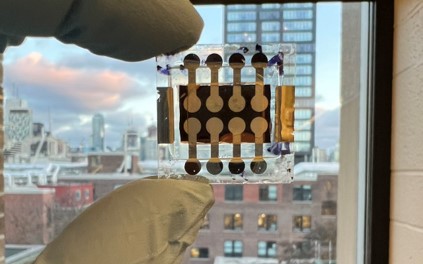From pv magazine global
A U.S.-Canadian research team has fabricated an inverted perovskite solar cell by using Lewis base molecules for surface passivation. Lewis bases are generally used in perovskite solar research to passivate surface defects in the perovskite layer. This has positive effects on energy level alignment, interfacial recombination kinetics, hysteresis behavior, and operational stability.
“Lewis basicity, which is inversely proportional to electronegativity, is expected to determine the binding energy and the stabilization of interfaces and grain boundaries,” the scientists said, noting that the molecules proved to be highly efficient in creating strong bonding between the cell layers at the interface level. “A Lewis base molecule with two electron-donating atoms can potentially bind and bridge interfaces and ground boundaries, offering the potential to enhance the adhesion and strengthen the mechanical toughness of perovskite solar cells.”
The scientists used a diphosphine Lewis base molecule known as 1,3-bis(diphenylphosphino) propane (DPPP) to passivate one of the most promising halide perovskites – the formamidinium lead iodide known as FAPbI3 – for use in a cell’s absorber layer.

Image: University of Toronto
They deposited the perovskite layer on a DPPP-doped hole transport layer (HTL) made of nickel(II) oxide (NiOx). They observed that some DPPP molecules redissolved and segregated at both the perovskite/NiOx interface and the perovskite surface regions, and that the crystallinity of the perovskite film improved. They said this step enhanced the mechanical toughness of the perovskite/NiOx interface.
The researchers built the cell with a substrate made of glass and tin oxide (FTO), the HTL based on NiOx, a layer of methyl-substituted carbazole (Me-4PACz) as the hole-transport layer, the perovskite layer, a thin layer of phenethylammonium iodide (PEAI), an electron transport layer made of buckminsterfullerene (C60), a tin(IV) oxide (SnO2) buffer layer, and a metal contact made of silver (Ag).
The team compared the performance of the DPPP-doped solar cell with a reference device that didn’t go through the treatment. The doped cell achieved a power conversion efficiency of 24.5%, an open-circuit voltage of 1.16 V and a fill factor of 82%. The undoped device reached an efficiency of 22.6%, an open-circuit voltage of 1.11 V and a fill factor of 79%.
“The improvement on fill factor and open-circuit voltage confirmed the reduction in defect density at the NiOx /perovskite front interface after DPPP treatment,” the scientists said.
The researchers also built a doped cell with an active area of 1.05 cm2 that achieved a power conversion efficiency of up to 23.9% and showed no degradation after 1,500 h.
“With DPPP, under ambient conditions – that is, no additional heating – the overall power conversion efficiency of the cell stayed high for approximately 3,500 hours,” said researcher Chongwen Li. “The perovskite solar cells that have been previously published in the literature tend to see a significant drop in their efficiency after 1,500 to 2,000 hours, so this is a big improvement.”
The group, which recently applied for a patent for the DPPP technique, presented the cell tech in “Rational design of Lewis base molecules for stable and efficient inverted perovskite solar cells,” which was recently published in Science. The team includes academics from the University of Toronto in Canada, as well as scientists from the University of Toledo, the University of Washington, and Northwestern University in the United States.
This content is protected by copyright and may not be reused. If you want to cooperate with us and would like to reuse some of our content, please contact: editors@pv-magazine.com.









By submitting this form you agree to pv magazine using your data for the purposes of publishing your comment.
Your personal data will only be disclosed or otherwise transmitted to third parties for the purposes of spam filtering or if this is necessary for technical maintenance of the website. Any other transfer to third parties will not take place unless this is justified on the basis of applicable data protection regulations or if pv magazine is legally obliged to do so.
You may revoke this consent at any time with effect for the future, in which case your personal data will be deleted immediately. Otherwise, your data will be deleted if pv magazine has processed your request or the purpose of data storage is fulfilled.
Further information on data privacy can be found in our Data Protection Policy.